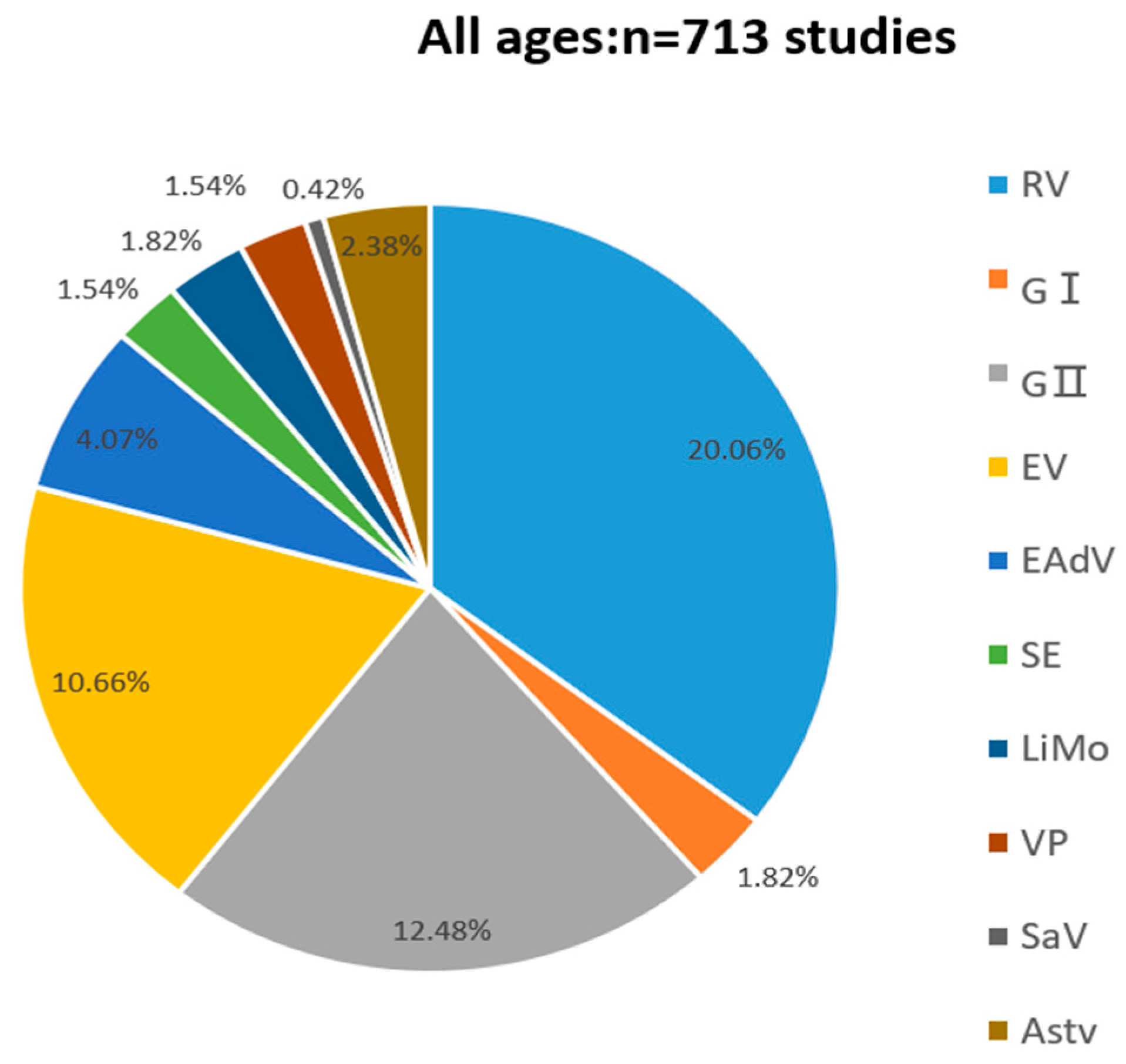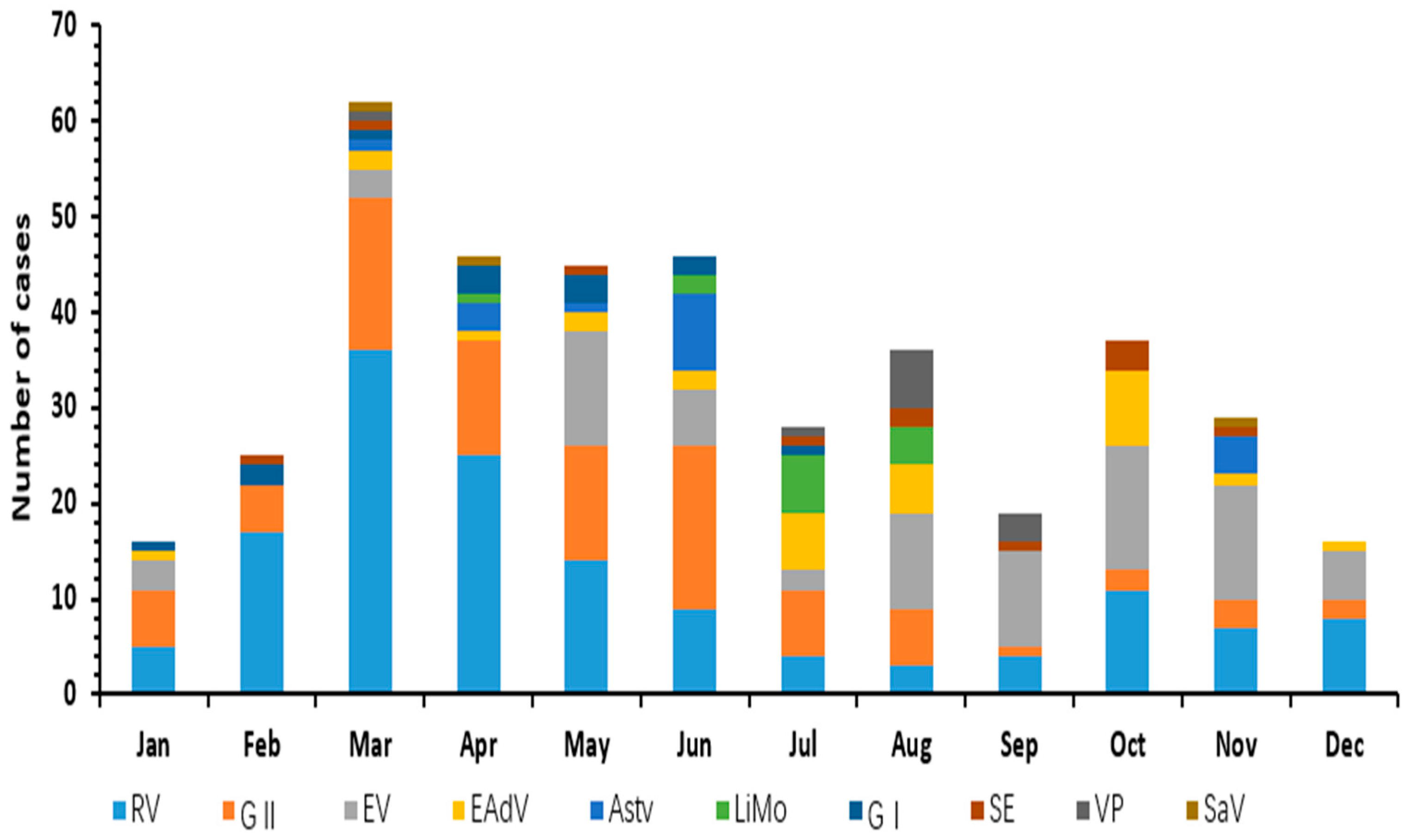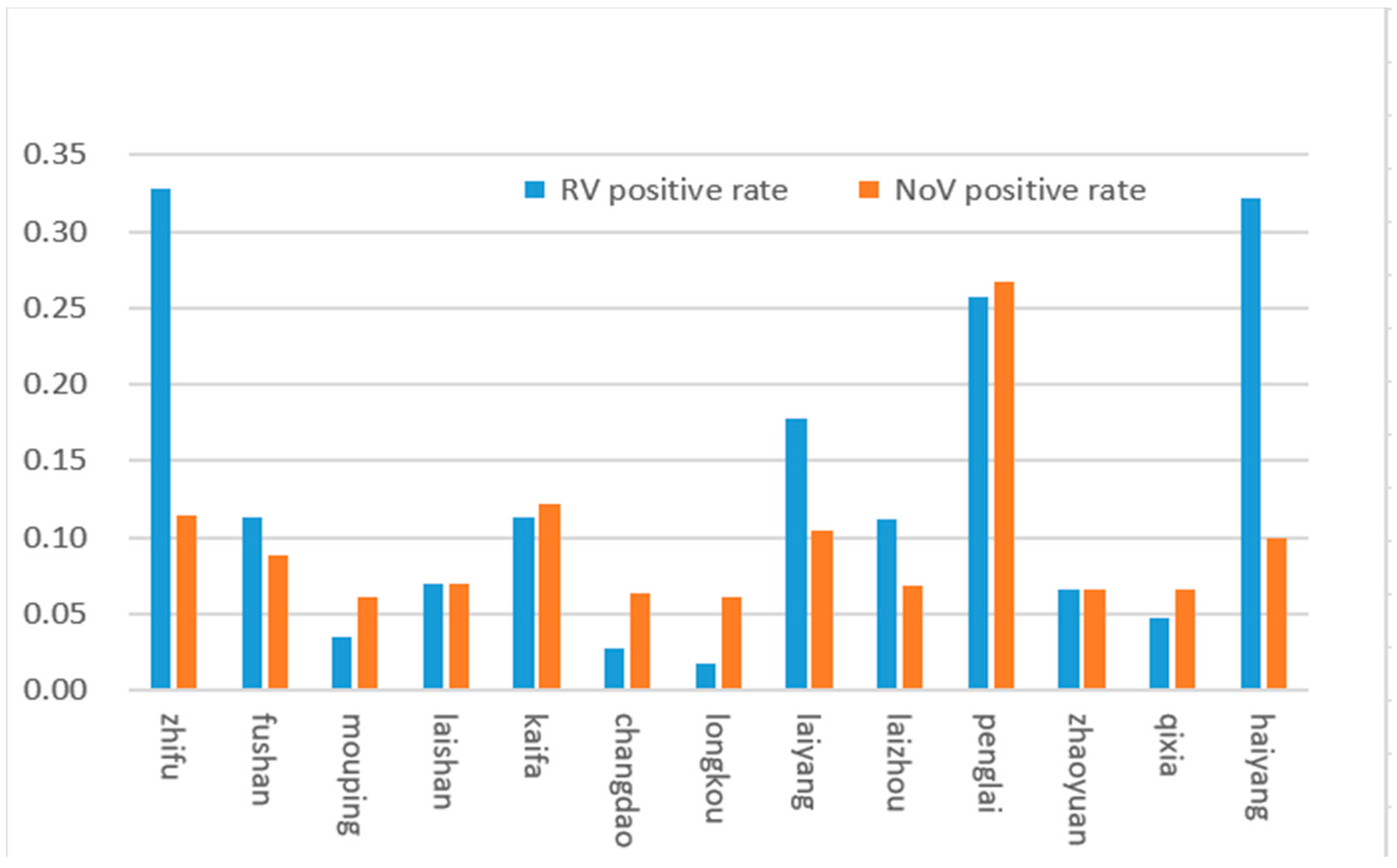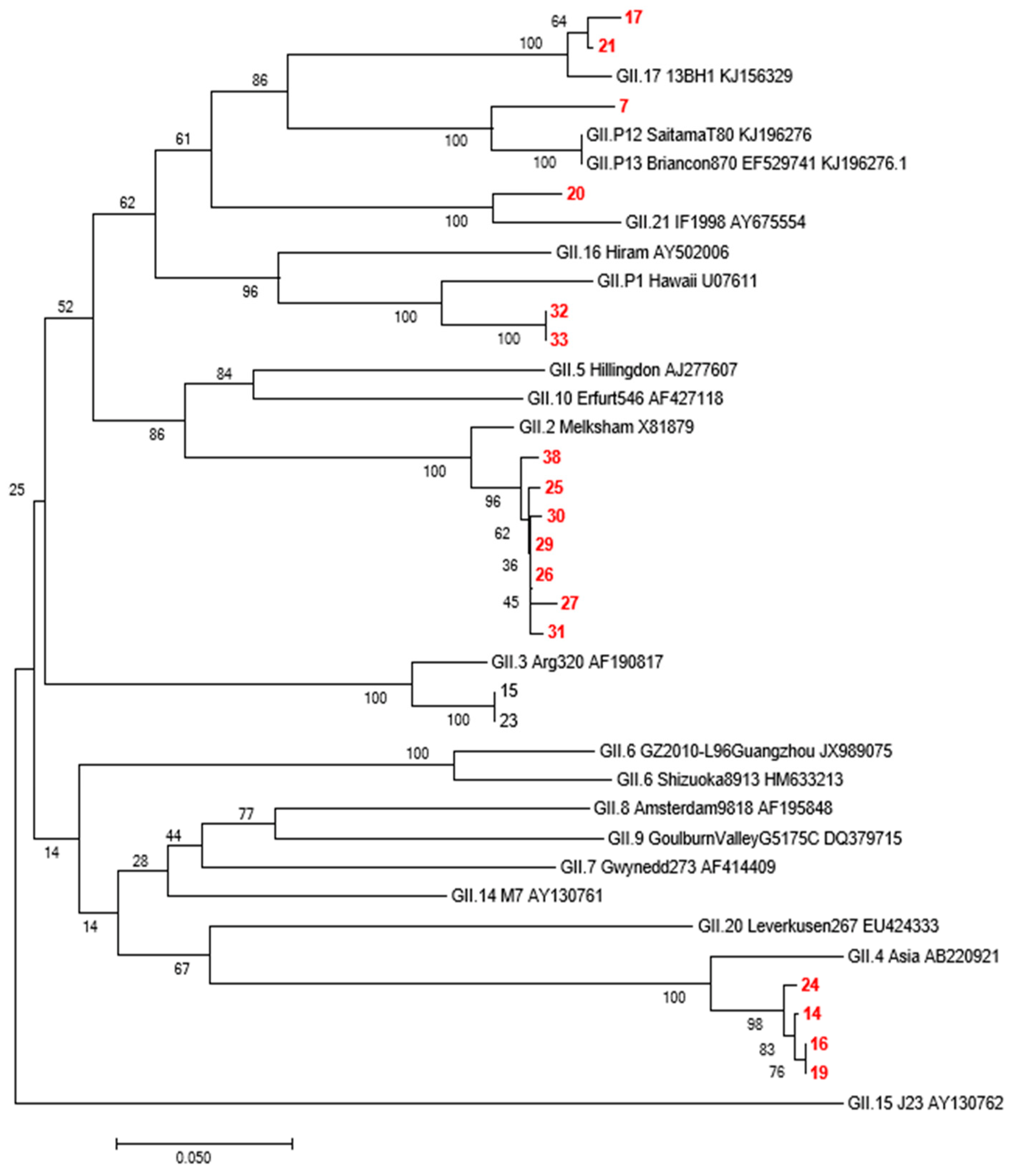Aetiological Characteristics of Infectious Diarrhea in Yantai City, Shandong Province, China in 2017
Abstract
1. Introduction
2. Materials and Methods
2.1. Sample Source and Sample Collection
2.2. Nucleic Acid Extraction and Detection
2.3. G/P Typing of Rotavirus
2.4. Genotyping of Norovirus GII Specimens
2.5. Statistical Methods
3. Results
3.1. Basic Information
3.2. Pathogenic Spectrum of Infectious Diarrhea
3.3. Seasonal Distribution of Pathogens in Diarrhea Specimens
3.4. Age Distribution of Patients with Infectious Diarrhea
3.5. Distribution of RV and NoVs in Each District of Yantai
3.6. Genotyping of RV-Positive Samples
3.7. Genotyping of GII Positive Samples
4. Discussion
5. Conclusions
Author Contributions
Funding
Institutional Review Board Statement
Informed Consent Statement
Data Availability Statement
Conflicts of Interest
Abbreviations
| RV | Rotavirus |
| NoVs | Norovirus |
| EV | Enterovirus universal |
| EAdV | Enteroadenovirus |
| SaV | Saru virus |
| Astv | Astrovirus |
| SE | Salmonella |
| LiMo | Listeria monocytogenes |
| VP | Vibrio parahaemolyticus |
| RT-PCR | reverse transcription-polymerase chain reaction |
| GI | Genogroup I |
| GII | Genogroup II |
References
- Wang, H.D.; Naghavi, M.; Allen, C.; Barber, R.M.; Bhutta, Z.A.; Carter, A.; Casey, D.C.; Charlson, F.J.; Chen, A.Z.; Coates, M.M.; et al. Global, regional, and national life expectancy, all—Cause mortality, and cause—Specific mortality for 249 causes of death, 1980–2015: A systematic analysis for the Global Burden of Disease Study 2015. Lancet 2016, 388, 1459–1544. [Google Scholar] [CrossRef]
- Zhang, P.; Zhang, J. Surveillance on other infectious diarrheal diseases in China from 2014 to 2015. Chin. J. Epidemiol. 2017, 38, 424–430. [Google Scholar] [CrossRef]
- Ministry of Health of the People’s Republic of China. WS 271—2007 Diagnostic Criteria for Infections Diarrhea; People’s Medical Publishing House: Beijing, China, 2007. [Google Scholar]
- Iturriza-Gómam, M.; Green, J.; Brown, D.W.D.; Desselberger, U.; Gray, J.J. Diversity within the VP4 gene of rotavirus P[8] strains: Implications for reverse transcription-PCR genotyping. J. Clin. Microbiol. 2000, 38, 898–901. [Google Scholar] [CrossRef] [PubMed]
- Ao, Y.; Wang, J.; Ling, H.; He, Y.; Dong, X.; Wang, X.; Peng, J.; Zhang, H.; Jin, M.; Duan, Z. Norovirus GII.P16/GII.2-associated gastroenteritis, China, 2016. Emerg. Infect. Dis. 2017, 23, 1172–1175. [Google Scholar] [CrossRef] [PubMed]
- Hall, T. BioEdit: An important software for molecular biology. GERF Bull. Biosci. 2011, 2, 6. [Google Scholar] [CrossRef]
- Swindell, S.R.; Plasterer, T.N. Seqman. In Sequence Data Analysis Guidebook; Springer: Totowa, NJ, USA, 1997; pp. 75–89. [Google Scholar] [CrossRef]
- Li, J.; Pan, H.; Xiao, W.J.; Gong, X.H.; Zhuang, Y.; Kuang, X.Z.; Wu, H.Y.; Yuan, Z.A. Epidemiological and etiological surveillance study of infectious diarrhea in Shanghai in 2013–2015. Chin. J. Prev. Med. 2017, 51, 1113–1117. [Google Scholar] [CrossRef]
- Luo, K.; Li, J.; Zhao, S.; Hu, S.; Deng, Z.; Ou, Y.; Zhang, X.; Long, Z.; Yao, Z.; Gao, L. Pathogen spectrum distribution of infectious diarrhea in Hunan province from 2015 to 2017. J. Trop. Dis. Parasitol. 2018, 16, 71–74. [Google Scholar] [CrossRef]
- Zhu, M.J.; Li, Y.; Wang, Y.B. Analysis on the 947 pathogens in infectious diarrhea in Shunyi district in Beijing from 2013 to 2015. Mod. Prev. Med. 2017, 44, 734–737. [Google Scholar]
- Yang, Y.N.; Li, H.J.; Li, Q.H. Bacterial diarrhea pathogen spectrum in Tongzhou district, Beijing, 2011–2015. Dis. Surveill. 2017, 32, 477–480. [Google Scholar] [CrossRef]
- Liu, Z.H.; Gong, S.T.; Zhong, J.Y.; Wang, C.B.; Zhu, B.; He, W. Detection results of stool samples from 985 infants and young children affected by viral diarrhea. Chin. J. Pract. Pediatrics. 2010, 25, 618–621. [Google Scholar]
- Lai, C.C.; Wu, F.T.; Ji, D.D.; Mu, J.J.; Yang, J.J.; Yang, J.R.; Chiu, K.T.; Lin, W.Y.; Lin, C.Y.; Fu, Y.P.; et al. Gastroenteritis in a Taipei emergency department: Aetiology and risk factors. Clin. Microbiol. Infect. 2011, 17, 1071–1077. [Google Scholar] [CrossRef] [PubMed][Green Version]
- Huang, F.; Deng, Y.; Qu, M.; Liu, G.R.; Liu, X. Etiological surveillance and analysis of infectious diarrhea in Beijing in year 2010. Chin. J. Prev. Med. 2011, 45, 820–824. [Google Scholar]
- He, D.M.; Ke, B.X.; Deng, X.L.; Ke, C.W.; Chen, J.D. Surveillance and analysis on the pathogenic features of Salmonella in Guangdong province in 2010. Chin. J. Prev. Med. 2012, 46, 424–429. [Google Scholar]
- Huang, E.M.; Wang, C.L.; Wang, M.; Lei, L.; Shi, W.Y.; Zheng, Y.K. Pathogenic analysis on the surveillance of infectious diarrhea in Zhongshan from 2015 to 2016. Mod. Prev. Med. 2017, 44, 3040–3043. [Google Scholar]
- Zhang, Z.; Li, Y.; Lu, Y.; Jiang, M.; Zhang, H.L.; Mei, S.J.; Xie, X. Surveillance for other infectious diarrheal diseases in Shenzhen, Guangdong, 2010–2015. Dis. Surveill. 2017, 32, 836–841. [Google Scholar] [CrossRef]
- He, Q.Y.; Chen, Z.Q.; Zou, Y.W. Epidemiological features of norovirus and rotavirus diarrhea in Meizhou from 2012 to 2017. Cap. J. Public Health 2019, 13, 48–50. [Google Scholar] [CrossRef]
- Forster, J.; Guarino, A.; Parez, N.; Moraga, F.; Roman, E.; Mory, O.; Tozzi, A.E.; Aguileta, A.L.; Wahn, U.; Graham, C.; et al. Hospital-based surveillance to estimate the burden of rotavirus gastroenteritis among European children younger than 5 years of age. Pediatrics 2009, 123, e393–400. [Google Scholar] [CrossRef]
- Ding, Z.Y.; Wei, C.C. Investigation and analysis of an outbreak of norovirus acute gastroenteritis in Wuxi city. World Latest Med. Inform. 2018, 18, 284–286. [Google Scholar] [CrossRef]
- Mizan, M.F.R.; Jahid, I.K.; Kim, M.; Lee, K.H.; Kim, T.J.; Ha, S.D. Variability in biofilm formation correlates with hydrophobicity and quorum sensing among Vibrio parahaemolyticus isolates from food contact surfaces and the distribution of the genes involved in biofilm formation. Biofouling 2016, 32, 497–509. [Google Scholar] [CrossRef]
- Zhou, Y.; Zhu, X.; Hou, H.; Lu, Y.; Yu, J.; Mao, J.; Mao, J.; Sun, Z. Characteristics of diarrheagenic Escherichia coli among children under 5 years of age with acute diarrhea: A hospital based study. BMC Infect. Dis. 2018, 18, 63. [Google Scholar] [CrossRef]
- Zeng, M.; Chen, J.; Gong, S.T.; Xu, X.H.; Zhu, Q.R. Epidemiological surveillance of norovirus and rotavirus diarrhea among outpatient children in five metropolitan cities. Chin. J. Pediatrics 2010, 48, 564–570. [Google Scholar]
- Merten, S.; Schaetti, C.; Manianga, C.; Lapika, B.; Hutubessy, R.; Chaignat, C.L.; Weiss, M. Sociocultural determinants of anticipated vaccine acceptance for acute watery diarrhea in early childhood in Katanga Province, Democratic epublic of Congo. Am. J. Trop. Med. Hyg. 2013, 89, 419. [Google Scholar] [CrossRef] [PubMed]
- Santos, N.; Hoshino, Y. Global distribution of rotavirus serotypes/genotypes and its implication for the development and im plementation of an effective rotavirus vaccine. Rev. Med. Virol. 2004, 15, 29–56. [Google Scholar] [CrossRef]
- World Health Organization. Diarrheal Disease [EB/OL]. Available online: http://www.who.int/mediacentre/factsheets/fs330/en/index.html (accessed on 2 January 2017).
- World Health Organization. Diarrhea: Why Children Are Stilldying and What Can Be Done [EB/OL]. Available online: http://www.who.int/maternal_child_adolescent/documents/789241598415/en/ (accessed on 2 January 2017).
- Xu, L.Y.; Yu, Z.X. Epidemiological features analysis of notifiable infectious diseases in mainland China, 2010–2016. Henan J. Prev. Med. 2018, 29, 244–247. [Google Scholar]





Publisher’s Note: MDPI stays neutral with regard to jurisdictional claims in published maps and institutional affiliations. |
© 2022 by the authors. Licensee MDPI, Basel, Switzerland. This article is an open access article distributed under the terms and conditions of the Creative Commons Attribution (CC BY) license (https://creativecommons.org/licenses/by/4.0/).
Share and Cite
Sun, Z.; Xu, J.; Niu, P.; Jin, M.; Gao, Q.; Zhang, R.; Wang, J.; Zhang, Y.; Ma, X. Aetiological Characteristics of Infectious Diarrhea in Yantai City, Shandong Province, China in 2017. Viruses 2022, 14, 216. https://doi.org/10.3390/v14020216
Sun Z, Xu J, Niu P, Jin M, Gao Q, Zhang R, Wang J, Zhang Y, Ma X. Aetiological Characteristics of Infectious Diarrhea in Yantai City, Shandong Province, China in 2017. Viruses. 2022; 14(2):216. https://doi.org/10.3390/v14020216
Chicago/Turabian StyleSun, Zhenlu, Jinjie Xu, Peihua Niu, Miao Jin, Qiao Gao, Ruiqing Zhang, Ji Wang, Yong Zhang, and Xuejun Ma. 2022. "Aetiological Characteristics of Infectious Diarrhea in Yantai City, Shandong Province, China in 2017" Viruses 14, no. 2: 216. https://doi.org/10.3390/v14020216
APA StyleSun, Z., Xu, J., Niu, P., Jin, M., Gao, Q., Zhang, R., Wang, J., Zhang, Y., & Ma, X. (2022). Aetiological Characteristics of Infectious Diarrhea in Yantai City, Shandong Province, China in 2017. Viruses, 14(2), 216. https://doi.org/10.3390/v14020216







